Text this colour links to Pages. Text this colour links to Family Trees. Text this colour are links that are disabled for Guests.
Place the mouse over images to see a larger image. Click on paintings to see the painter's Biography Page. Mouse over links for a preview. Move the mouse off the painting or link to close the popup.
County Dublin is in Province of Leinster.
Before 28th August 1799 Nicholas Lawless 1st Baron Cloncurry (age 63) commissioned the building of Maretimo House and Lyons House.
Brennanstown aka Glen Druid Cromlech is also in Prehistoric Ireland.
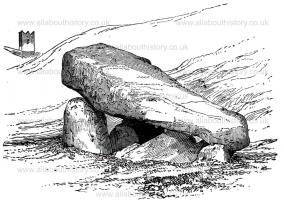
Handbook of Irish Antiquities by Wakeman Chapter 1. Brennanstown (Glen Druid) Cromlech [Map]. In a picturesque valley, close to Cabinteely, County Dublin, stands a very perfect cromlech. This monument may be reached in a short walk from the Carrickmines railway station. The site is a little over one mile and a-half from the sea-coast. The covering stone is of an irregular form, but the under portion, which forms the top of the chamber, is quite flat and horizontal. The following are its dimensions: length and breadth, 15½ feet; thickness, 3 to 5 feet. It is not easy to calculate the weight of this mass, on account of the irregularity of form which the block presents; but it is estimated at 36 tons. It rests, as Mr. Borlase points out, on two antæ, as well as on the larger stones, and so forms an ante-chamber 5 feet wide at the entrance. A number of detached stones lying72 about this very perfect example would indicate that it was originally accompanied by a circle of standing stones.
On 6th May 1861 Charles Michael Edgeworth Brinkley was born at Knockmaroon. He was educated at Clifton College Bristol, Jesus College, Cambridge University and the Royal Military College, Sandhurst. He married 3rd March 1892 Evelyn Everard Hutton and had issue.
Shanganagh aka Killiney aka Ballybrack Cromlech is also in Prehistoric Ireland.
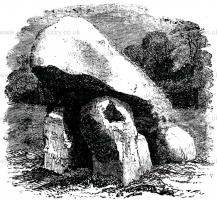
Handbook of Irish Antiquities by Wakeman Chapter 1. Shanganagh Cromlech [Map]. At Shanganagh, half a mile to the east of the hamlet of Loughlinstown, may be seen a fine specimen of what may be styled, as regards size, a cromlech of the second class. It is supported upon four stones, and presents no appearance of having been enveloped in a mound of any description. Like nearly every one of its kindred remains in the County Dublin, it is formed of granite blocks. The covering stone measures 9 feet in length by 7 feet at its greatest breadth; it is 3½ feet in its extreme thickness; and its highest portion is at present slightly over 9 feet above the ground; the weight is about 12 tons. The chamber would seem to extend east and west. The cromlech may be easily visited from Killiney railway station.
The Giant's Grave aka Kilternan Cromlech is also in Prehistoric Ireland.
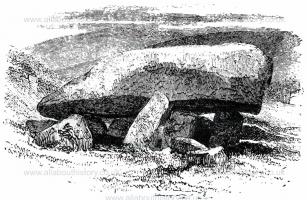
Handbook of Irish Antiquities by Wakeman Chapter 1. Kilternan Cromlech [Map] is near Kilternan House, 7 miles from Dublin, and half a mile west of Golden Ball. It is another fine example of its class, when we consider the weight of its table, estimated at 40 tons, and the difficulty, as we must suppose, of raising, in a rude age, such a mass upon supporters. The covering stone, like all others, of this monument is of the granite of the district. Its measurements are: extreme length, 22 feet; width, 13½ feet; greatest thickness, 6 feet 6 inches. The supporters vary in height from 2 to 4 feet, but it is impossible to know how far they may be sunk below the present ground level. Some considerable disturbance in their arrangement appears to have occurred. Several would seem to have subsided, but the roofing69 block is still held above ground by the others; the height of the enclosure may be stated as about five feet from floor to roof. The plan of the chamber is very irregular, but it may be described as extending east and west. This cromlech is known as 'the giant's grave'; but there is no local tradition connected with it, folklore in this district having generations ago ceased to exist.
Mount Venus Burial Mound is also in Prehistoric Ireland.
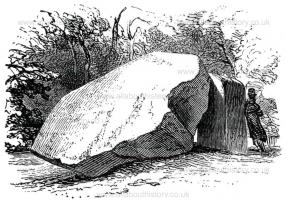
Handbook of Irish Antiquities by Wakeman Chapter 1. Mount Venus Cromlech [Map]. This monument, situated at Woodtown, about two and a half miles from Rathfarnham, a suburb of Dublin, is no longer perfect. Its table, which may have slipped from its original position, is at present supported by a single stone about 7½ feet in height, and of considerable massiveness. The greatest measurement of the covering stone is 23 feet; it is 12 feet in breadth, and 5 feet in thickness. It is supported at the north-west corner by an upright stone, forming with it an angle of 45°. Several of the former supporting stones would seem to have been removed, and others have evidently been broken. The rock is70 granite, of a very hard, close, and durable description. It seems to have weathered but little, as all the remaining stones present angles of considerable sharpness. Du Noyer was of opinion that this cromlech was of what he styled the 'earth-fast' class, and that the roof had always in part rested upon the ground. In this supposition O'Neill, no mean authority on such matters, did not by any means coincide. The weight of the covering stone is estimated at 42 tons. So great a pressure might well cause some of the weaker supporters to give way, in which case the pile would very probably assume its present appearance. It is not in the least likely that this tomb had at any time been covered by a tumulus or cairn. Mr. Borlase considers it 'one of the most magnificent megalithic monuments in the world.'
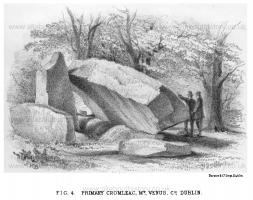
Journal of the Historical and Archaeological Association of Ireland 1868 Pages 40-46. The last illustration is that of the so-called ruined cromleac at Mount Venus, county Dublin [Mount Venus Burial Mound [Map]], (see Plate facing this page, fig. 4). Beyond a question this remain is a genuine "primary," or "earth-fast" cromleac, and is as fine an example of its type as we possess in Ireland. The two enormous blocks forming it are of granite, the larger inclined stone being about 18' + 8' + 4'; the upright stone against which it rests being about eight feet above the ground, and over three feet square. I regret I have not the exact measurements of those blocks; but these given are not very far astray.
In point of construction, this cromleac very closely resembles that at Rathkenny, as will be apparent by reference to the illustrations.